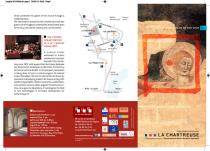La Chartreuse du Val de Bénédiction owes its beginnings to Pope Innocent VI. After his election in 1352, the then cardinal donated his lands and a private residence he owned at Villeneuve lez Avignon. Works began quickly on the initial foundations, originally planned for twelve monks, and the monastery was granted numerous privileges. The decoration of its private chapel was entrusted to Matteo Giovannetti, who had painted the frescoes in the Palace of the Popes. Pope Innocent VI had close ties with the monastery and, at his request, he was buried there when he died in 1362. His mausoleum, a monument which was removed after the Revolution, was returned to the church in 1959. The work begun by Innocent VI was carried on by his nephew, Pierre Selva de Montirac, Cardinal of Pampelona, who finished building the Saint John Cloister in 1372. Over the centuries, the monastery grew richer, more influential and more beautiful, with decorations by François Des Royers de la Valfenière in particular. Its three cloisters made it the biggest Carthusian monastery in France.
At the time of the French Revolution, it was divided into lots and sold, its library and works of art were scattered and the monastery was severely damaged.
In 1835, the deterioration of the church and its frescoes attracted the attention of the writer Prosper Mérimée, who was then Inspector of Historical Monuments. He immediately started conservation proceedings. In 1909, the State began to rehabilitate the monastery, commissioning architect
Jules Formigé to make a complete survey of all buildings. The first restoration work was begun and the decision was taken to buy back, little by little, all the buildings in the original precinct.
Today, much of the monastery has been restored and visitors enjoy its harmonious proportions, the secluded charm of its cloisters and the shafts of light
At the time of the French Revolution, it was divided into lots and sold, its library and works of art were scattered and the monastery was severely damaged.
In 1835, the deterioration of the church and its frescoes attracted the attention of the writer Prosper Mérimée, who was then Inspector of Historical Monuments. He immediately started conservation proceedings. In 1909, the State began to rehabilitate the monastery, commissioning architect
Jules Formigé to make a complete survey of all buildings. The first restoration work was begun and the decision was taken to buy back, little by little, all the buildings in the original precinct.
Today, much of the monastery has been restored and visitors enjoy its harmonious proportions, the secluded charm of its cloisters and the shafts of light
A cultural center dedicated to artists residencies has been housed in the monastery since 1973, with support from the Caisse Nationale des Monuments Historiques et des Sites, the Ministry of Culture and local bodies. In this prospect, restoration is being done to host a cultural program of national scope.
The National Playwriting Centre (Centre national des écritures du spectacle) is a major venue in France and in Europe for residencies for playwrights and drama groups.
Each year the Centre has nearly sixty residencies, hosting authors, companies, research and experimental laboratories, training and master classes. The Centre also oftenopens to the public for rehearsals and other events prepared by the residents and guest artists, particularly in July in partnership with the Avignon Festival.
The National Playwriting Centre (Centre national des écritures du spectacle) is a major venue in France and in Europe for residencies for playwrights and drama groups.
Each year the Centre has nearly sixty residencies, hosting authors, companies, research and experimental laboratories, training and master classes. The Centre also oftenopens to the public for rehearsals and other events prepared by the residents and guest artists, particularly in July in partnership with the Avignon Festival.




